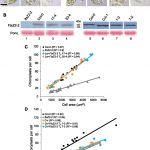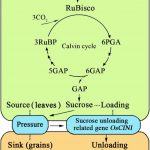CO2 and O2 as Drivers of Plant Macroevolution
The evolution of photosynthesis and, at a later point, the emergence of land plants resulted in substantial changes in the composition of  Earth’s atmosphere. Plant colonization of the land in the early Paleozoic (more than 450 million years ago [mya]) was followed by a rapid drop in atmospheric [CO2], while at the same time atmospheric [O2] concentrations built up to a likely maximum of 26% or more during the Carboniferous. Following this, increased plate tectonics activity and volcanism during the Mesozoic (251–65.5 mya) led to consistently high [CO2] for 100 million years, followed by a significant drop down to preindustrial [CO2] levels, coinciding with the radiation of angiosperms. Correlative considerations of the fossil record and models of atmospheric [O2] and [CO2] over the last 500 million years by Yiotis and McElwain (10.1104/pp.19.00749) suggest that the timing of major evolutionary tipping points (i.e. when former dominant plant groups are ecologically replaced by others that have newly evolved) between the three major evolutionary groups of vascular plants (i.e. monilophytes, gymnosperms, and angiosperms) coincided with significant changes in Earth’s atmospheric composition. At the broadest scale, lycophytes and monilophytes (i.e. ferns and fern allies) dominated the Carboniferous (358.9 to 298.9 mya) coal swamp landscapes, but their dominance ended abruptly as [CO2] started to build up during the late Paleozoic and Triassic (251.9 to 201.3 mya), when monilophytes were ecologically replaced by the gymnosperms. Gymnosperms proved to be very successful under the high [CO2] greenhouse conditions of the Mesozoic (251 to 65.5 mya), spreading from pole to pole and dominating the Mesozoic forests. Their eventual decline began during the Cretaceous (145 to 66 mya), a period marked by rapid atmospheric change in the form of a decline in [CO2] and a likely spike in [O2] and by the emergence of the angiosperms.
Earth’s atmosphere. Plant colonization of the land in the early Paleozoic (more than 450 million years ago [mya]) was followed by a rapid drop in atmospheric [CO2], while at the same time atmospheric [O2] concentrations built up to a likely maximum of 26% or more during the Carboniferous. Following this, increased plate tectonics activity and volcanism during the Mesozoic (251–65.5 mya) led to consistently high [CO2] for 100 million years, followed by a significant drop down to preindustrial [CO2] levels, coinciding with the radiation of angiosperms. Correlative considerations of the fossil record and models of atmospheric [O2] and [CO2] over the last 500 million years by Yiotis and McElwain (10.1104/pp.19.00749) suggest that the timing of major evolutionary tipping points (i.e. when former dominant plant groups are ecologically replaced by others that have newly evolved) between the three major evolutionary groups of vascular plants (i.e. monilophytes, gymnosperms, and angiosperms) coincided with significant changes in Earth’s atmospheric composition. At the broadest scale, lycophytes and monilophytes (i.e. ferns and fern allies) dominated the Carboniferous (358.9 to 298.9 mya) coal swamp landscapes, but their dominance ended abruptly as [CO2] started to build up during the late Paleozoic and Triassic (251.9 to 201.3 mya), when monilophytes were ecologically replaced by the gymnosperms. Gymnosperms proved to be very successful under the high [CO2] greenhouse conditions of the Mesozoic (251 to 65.5 mya), spreading from pole to pole and dominating the Mesozoic forests. Their eventual decline began during the Cretaceous (145 to 66 mya), a period marked by rapid atmospheric change in the form of a decline in [CO2] and a likely spike in [O2] and by the emergence of the angiosperms.



